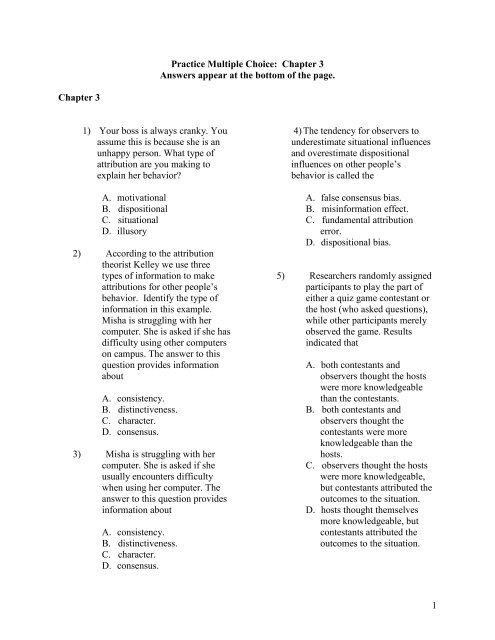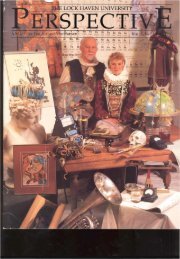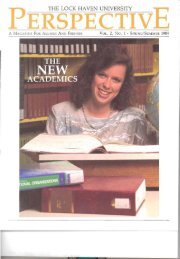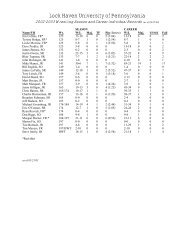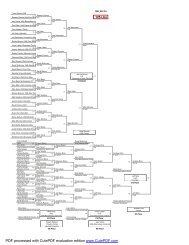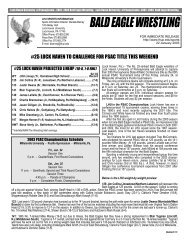1 Practice Multiple Choice: Chapter 3 Answers appear at the bottom ...
1 Practice Multiple Choice: Chapter 3 Answers appear at the bottom ...
1 Practice Multiple Choice: Chapter 3 Answers appear at the bottom ...
You also want an ePaper? Increase the reach of your titles
YUMPU automatically turns print PDFs into web optimized ePapers that Google loves.
<strong>Practice</strong> <strong>Multiple</strong> <strong>Choice</strong>: <strong>Chapter</strong> 3<br />
<strong>Answers</strong> <strong>appear</strong> <strong>at</strong> <strong>the</strong> <strong>bottom</strong> of <strong>the</strong> page.<br />
<strong>Chapter</strong> 3<br />
1) Your boss is always cranky. You<br />
assume this is because she is an<br />
unhappy person. Wh<strong>at</strong> type of<br />
<strong>at</strong>tribution are you making to<br />
explain her behavior?<br />
A. motiv<strong>at</strong>ional<br />
B. dispositional<br />
C. situ<strong>at</strong>ional<br />
D. illusory<br />
2) According to <strong>the</strong> <strong>at</strong>tribution<br />
<strong>the</strong>orist Kelley we use three<br />
types of inform<strong>at</strong>ion to make<br />
<strong>at</strong>tributions for o<strong>the</strong>r people’s<br />
behavior. Identify <strong>the</strong> type of<br />
inform<strong>at</strong>ion in this example.<br />
Misha is struggling with her<br />
computer. She is asked if she has<br />
difficulty using o<strong>the</strong>r computers<br />
on campus. The answer to this<br />
question provides inform<strong>at</strong>ion<br />
about<br />
A. consistency.<br />
B. distinctiveness.<br />
C. character.<br />
D. consensus.<br />
3) Misha is struggling with her<br />
computer. She is asked if she<br />
usually encounters difficulty<br />
when using her computer. The<br />
answer to this question provides<br />
inform<strong>at</strong>ion about<br />
A. consistency.<br />
B. distinctiveness.<br />
C. character.<br />
D. consensus.<br />
4) The tendency for observers to<br />
underestim<strong>at</strong>e situ<strong>at</strong>ional influences<br />
and overestim<strong>at</strong>e dispositional<br />
influences on o<strong>the</strong>r people’s<br />
behavior is called <strong>the</strong><br />
A. false consensus bias.<br />
B. misinform<strong>at</strong>ion effect.<br />
C. fundamental <strong>at</strong>tribution<br />
error.<br />
D. dispositional bias.<br />
5) Researchers randomly assigned<br />
participants to play <strong>the</strong> part of<br />
ei<strong>the</strong>r a quiz game contestant or<br />
<strong>the</strong> host (who asked questions),<br />
while o<strong>the</strong>r participants merely<br />
observed <strong>the</strong> game. Results<br />
indic<strong>at</strong>ed th<strong>at</strong><br />
A. both contestants and<br />
observers thought <strong>the</strong> hosts<br />
were more knowledgeable<br />
than <strong>the</strong> contestants.<br />
B. both contestants and<br />
observers thought <strong>the</strong><br />
contestants were more<br />
knowledgeable than <strong>the</strong><br />
hosts.<br />
C. observers thought <strong>the</strong> hosts<br />
were more knowledgeable,<br />
but contestants <strong>at</strong>tributed <strong>the</strong><br />
outcomes to <strong>the</strong> situ<strong>at</strong>ion.<br />
D. hosts thought <strong>the</strong>mselves<br />
more knowledgeable, but<br />
contestants <strong>at</strong>tributed <strong>the</strong><br />
outcomes to <strong>the</strong> situ<strong>at</strong>ion.<br />
1
6) We tend to underestim<strong>at</strong>e <strong>the</strong><br />
situ<strong>at</strong>ional determinants of<br />
o<strong>the</strong>rs’ behavior but not our own<br />
because we observe o<strong>the</strong>rs from<br />
a different perspective than we<br />
observe ourselves. This is known<br />
as <strong>the</strong><br />
A. camera perspective bias.<br />
B. changing perspectives trend.<br />
C. self-awareness phenomenon.<br />
D. actor-observer difference.<br />
7) Bergh, Chen & Burrows found<br />
th<strong>at</strong> whe<strong>the</strong>r participants were<br />
rude or polite depended on wh<strong>at</strong><br />
type of words <strong>the</strong>y had<br />
unscrambled previously. This<br />
priming study illustr<strong>at</strong>es wh<strong>at</strong><br />
principle?<br />
A. The fundamental <strong>at</strong>tribution<br />
error<br />
B. How our behavior can be<br />
affected by situ<strong>at</strong>ional factors<br />
even though we may not be<br />
aware of <strong>the</strong> effect.<br />
C. Personality is <strong>the</strong> primary<br />
determinant of social<br />
behavior.<br />
D. Social intuition is almost<br />
always accur<strong>at</strong>e.<br />
8) One reason th<strong>at</strong> people tend to<br />
be overconfident is:<br />
A. They’ve been encouraged to<br />
have high self-esteem<br />
B. They aren’t exposed to<br />
criticism.<br />
C. They are not aware of gaps<br />
in <strong>the</strong>ir knowledge or skill<br />
D. They see o<strong>the</strong>r people make<br />
<strong>the</strong> same sort of mistakes<br />
9) People in Western cultures are<br />
more inclined to assume th<strong>at</strong><br />
o<strong>the</strong>rs’ behaviors<br />
A. do not cause events.<br />
B. are caused by <strong>the</strong> situ<strong>at</strong>ion.<br />
C. do not reflect inner traits.<br />
D. reflect inner traits.<br />
10) Sharon typically w<strong>at</strong>ches<br />
televised news st<strong>at</strong>ions th<strong>at</strong><br />
support her existing political<br />
beliefs. She is less inclined to<br />
w<strong>at</strong>ch <strong>the</strong> news on o<strong>the</strong>r st<strong>at</strong>ions,<br />
as it may disprove her<br />
preconceptions. Sharon’s<br />
approach illustr<strong>at</strong>es <strong>the</strong><br />
A. confirm<strong>at</strong>ion bias.<br />
B. misinform<strong>at</strong>ion effect.<br />
C. base-r<strong>at</strong>e fallacy.<br />
D. I-knew-it-all-along<br />
phenomenon.<br />
11) Which of <strong>the</strong> following is a<br />
thinking str<strong>at</strong>egy th<strong>at</strong> enables<br />
quick, efficient judgments?<br />
A. an implicit <strong>at</strong>titude<br />
B. an explicit <strong>at</strong>titude<br />
C. a heuristic<br />
D. a confirm<strong>at</strong>ion bias<br />
12) On <strong>the</strong> first day of class, we see<br />
a middle-aged man <strong>at</strong> <strong>the</strong> front of<br />
<strong>the</strong> room, talking to a younger<br />
man. If we assume <strong>the</strong> older man<br />
is <strong>the</strong> professor and <strong>the</strong> younger<br />
man is <strong>the</strong> student, we are relying<br />
on wh<strong>at</strong> heuristic?<br />
A. availability<br />
B. represent<strong>at</strong>iveness<br />
C. vividness<br />
D. m<strong>at</strong>ching<br />
2
13) Assuming most crimes involve<br />
violence because <strong>the</strong> news<br />
generally reports on rapes,<br />
robberies and be<strong>at</strong>ings is an<br />
example of <strong>the</strong> _______<br />
heuristic.<br />
A. m<strong>at</strong>ching<br />
B. represent<strong>at</strong>iveness<br />
C. vividness<br />
D. availability<br />
14) The perception of a rel<strong>at</strong>ionship<br />
where none actually exists, or <strong>the</strong><br />
perception of a stronger<br />
rel<strong>at</strong>ionship than actually exists,<br />
is called<br />
A. a represent<strong>at</strong>ive heuristic.<br />
B. an availability heuristic.<br />
C. an illusory correl<strong>at</strong>ion.<br />
D. <strong>the</strong> overconfidence<br />
phenomenon.<br />
15) Researchers (Snyder, Tanke, &<br />
Berscheid) had male students<br />
speak by telephone with women<br />
<strong>the</strong>y thought were ei<strong>the</strong>r<br />
<strong>at</strong>tractive or un<strong>at</strong>tractive. This<br />
inform<strong>at</strong>ion affected <strong>the</strong> way<br />
men spoke to <strong>the</strong> women. When<br />
judges l<strong>at</strong>er analyzed <strong>the</strong><br />
women’s comments, <strong>the</strong>y found<br />
th<strong>at</strong> <strong>the</strong><br />
D. women thought to be<br />
un<strong>at</strong>tractive spoke more<br />
slowly and deliber<strong>at</strong>ely.<br />
16) You enter a party thinking th<strong>at</strong> <strong>the</strong><br />
people <strong>the</strong>re will be friendly to a<br />
newcomer. Thus, you approach several<br />
people and start convers<strong>at</strong>ions with<br />
<strong>the</strong>m. They are indeed friendly to you.<br />
This phenomenon where your<br />
expect<strong>at</strong>ions affect your behavior and in<br />
turn affect <strong>the</strong> behaviors of o<strong>the</strong>rs is<br />
called:<br />
A. correspondence<br />
B. fundamental <strong>at</strong>tribution<br />
C. self-fulfilling prophecy<br />
D. actor-observer difference<br />
17. Jones’ <strong>the</strong>ory of correspondent<br />
inference says th<strong>at</strong> some behaviors<br />
are more inform<strong>at</strong>ive or diagnostic<br />
than o<strong>the</strong>rs. The most inform<strong>at</strong>ive<br />
behaviors are:<br />
A. Consistent, distinctive, and have<br />
high consensus<br />
B. Autom<strong>at</strong>ic, controlled, and<br />
represent<strong>at</strong>ive<br />
C. Confirmed, available, and<br />
confident<br />
D. Freely chosen, unexpected, and<br />
have noncommon effects<br />
A. women thought to be<br />
<strong>at</strong>tractive spoke more warmly<br />
than <strong>the</strong> o<strong>the</strong>r women.<br />
B. women thought to be<br />
un<strong>at</strong>tractive tried harder to be<br />
likable and stimul<strong>at</strong>ed better<br />
convers<strong>at</strong>ion.<br />
C. women thought to be<br />
<strong>at</strong>tractive spoke in a more<br />
aloof and superior manner.<br />
3
18. In his explan<strong>at</strong>ion of <strong>the</strong><br />
fundamental <strong>at</strong>tribution error, Gilbert<br />
argues th<strong>at</strong> <strong>at</strong>tribution is a two step<br />
process. The reason we often make<br />
<strong>the</strong> fundamental <strong>at</strong>tribution error is<br />
because:<br />
A. We are so focused on ourselves<br />
th<strong>at</strong> we fail to notice factors th<strong>at</strong><br />
may influence o<strong>the</strong>r people’s<br />
behavior.<br />
B. Making dispositional <strong>at</strong>tributions<br />
is autom<strong>at</strong>ic, but incorpor<strong>at</strong>ing<br />
inform<strong>at</strong>ion about situ<strong>at</strong>ional<br />
influence takes time and effort.<br />
C. We make judgments based on<br />
stereotypes and <strong>the</strong> see<br />
inform<strong>at</strong>ion th<strong>at</strong> confirms our<br />
beliefs.<br />
D. Being raised in a collectivist<br />
society affects how we perceive<br />
o<strong>the</strong>rs.<br />
19. You observe two young women in<br />
class. One wears casual but,<br />
fashionable clo<strong>the</strong>s similar to wh<strong>at</strong><br />
many o<strong>the</strong>r students wear, whereas<br />
<strong>the</strong> second dresses more formally<br />
for class. According to<br />
correspondent inference <strong>the</strong>ory of<br />
<strong>at</strong>tribution, which of <strong>the</strong><br />
following is true?<br />
A. You are more likely to assume<br />
<strong>the</strong> first woman’s choice of<br />
clo<strong>the</strong>s reveals her personality<br />
because she is conforming to<br />
social norms of dress.<br />
B. Both women are free to choose<br />
wh<strong>at</strong>ever <strong>the</strong>y wear to class, so<br />
you think <strong>the</strong>ir dressing styles are<br />
equally reflective of <strong>the</strong>ir<br />
personalities.<br />
C. You are more likely to assume<br />
<strong>the</strong> second woman’s choice of<br />
clo<strong>the</strong>s reveals her personality<br />
because she is not following<br />
social norms of dress, thus her<br />
style is more unexpected.<br />
D. There are more positive<br />
consequences of <strong>the</strong> second<br />
woman’s style of dress, e.g.,<br />
professor will take her more<br />
seriously, so you assume <strong>the</strong><br />
woman has been rewarded for<br />
dressing th<strong>at</strong> way.<br />
20) “Implicit” thinking th<strong>at</strong> is<br />
effortless, habitual and without<br />
awareness is called<br />
A. controlled processing.<br />
B. intentional processing.<br />
C. internal processing.<br />
D. autom<strong>at</strong>ic processing.<br />
1. B 11. C<br />
1. B 12. B<br />
3. A 13. D<br />
4. C 14. C<br />
5. A 15. A<br />
6. D 16. C<br />
7. B 17. D<br />
8. C 18. B<br />
9. D 19. C<br />
10. A 20. D<br />
4


